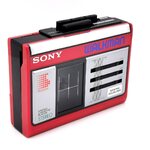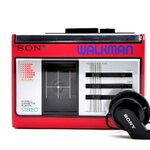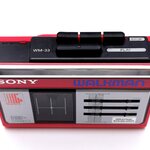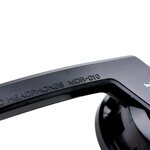 WM-33
WM-33

Technical details, specifications
- Battery
- 2AA
- Battery life
- 8h (with 2)
- Colors
- black red blue (dark) gray (matte)
- Dimensions
- 120*88.2*35.2 mm (373 cm³)3D size
- Weight
- 220 gr
- Window
- yes
- Frame
- plastic
- Case
- plastic
- Carry
- clip
- Expandable
- no
- External compartment
- no
- Tape selector
- Manual switch
- Waterproof
- no
- Speaker
- no
- Frequency range
- 40-14000@1,@2,@4 Hz
- FMax output
- 2x15 mW
Functions
- DC in
- yes
- Record by input
- no
- Record by int mic
- no
- Hotline mode
- no
- Cue
- no
- Balance (L/R)
- no
- Phone type
- 1
- Equalizer
- yes (vis)
- Auto reverse
- no
- Anti rolling
- no
- Logic control
- no
- Hold lock
- no
- Noise reduction
- no
- Radio
- no
- Remote control
- no
- Wireless headphone
- no
- Indicator
- led
Description
A simple Walkman with 3 band equalizer.
WM-33 and WM-43 feature a status LED, WM-32 does not.
Came with the MDR-010L headphones.
The basic WM-33 was an entry-level model that aimed to offer Sony quality and prestige in a market segment that contained many offerings from lesser manufacturers, branded or otherwise. Previously, the WM-22 had done very well, offering high quality and durability at a very economical price.
To keep the cost down, the WM-33 used some novel techniques. For the first time, the mechanism and the electronic printed circuit were not two separate parts but assembled as one, with the mechanical parts being assembled through holes in the circuit board. The mechanism was mostly made from moulded plastic. In its absence of screws or other fixings it was mostly assembled by clipping the various parts together. The whole assembly was fitted into the cabinet without screws, instead pegs and spigots kept it in place.
Despite this clever design, the WM-33 could not match sturdiness nor the sound quality of the previous WM-22. Rigidity is an important aspect of the design of any tape recorder and the WM-33 was just not strong enough to give really good results. The amplifiers also did not seem capable of the same volume and clarity as those of the earlier model. Even the fitting of a graphic equaliser, an unusual feature for a budget machine, did not help to redress the balance.
Although a step in the wrong direction, the WM-33 still sold well. Its mechanism and technique of construction were both used in many other models.Via Walkman Central (edited)











No comments yet